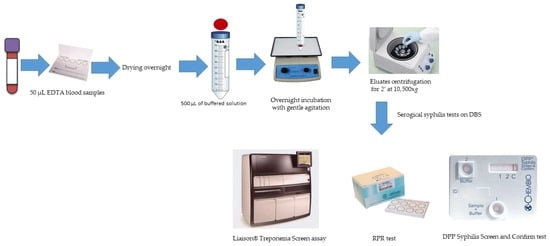- Article
Usefulness of Dried Blood Spot Samples for Syphilis Screening
- Victoria González Soler,
- Gema Fernández-Rivas and
- Héctor Martínez Riveros
- + 7 authors
Dried blood spots (DBSs) are a practical tool for diagnosing infectious diseases, especially in remote or resource-limited settings. This study assessed the efficacy of DBS-based serological assays for syphilis screening. EDTA blood samples from 171 syphilis-seropositive and 122 seronegative individuals were used to prepare DBSs by spotting whole blood onto filter paper. After drying, 12 mm disks were punched, incubated overnight in buffered solution, and centrifuged. Syphilis serological screening was conducted using the Liaison® Treponema Screen assay, Macro-Vue™ Reagin Plasma Rapid (RPR) card test, and Dual Path Platform (DPP) Syphilis Screen and Confirm test. The Liaison® assay demonstrated 100% sensitivity, specificity, positive predictive value (PPV), and negative predictive value (NPV) with an optimized cut-off. The nontreponemal RPR test showed very low sensitivity (2.9%) on DBS but perfect specificity (100%). The DPP test for treponemal antibodies achieved high sensitivity (92.1%) and specificity (98.2%) with microreader adjustment. Visual reading of the DPP test had variable accuracy, with sensitivity reaching 100% but lower specificity (42.1%). Nontreponemal antibody detection by DPP showed moderate sensitivity and specificity. Although nontreponemal testing requires refinement, DBS testing combined with point-of-care tests like DPP holds promise for expanding syphilis screening accessibility and decentralization globally, particularly in resource-constrained environments.
4 November 2025


